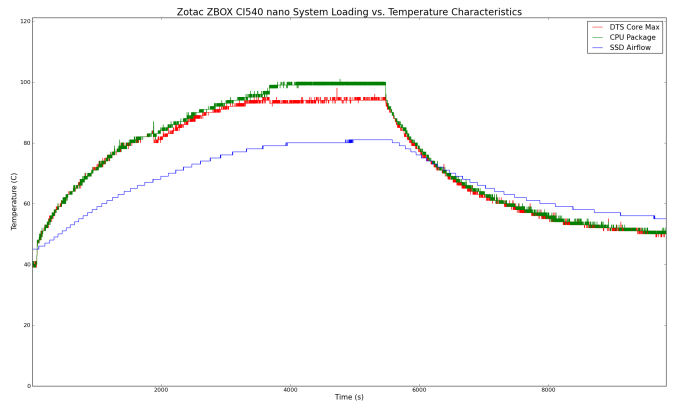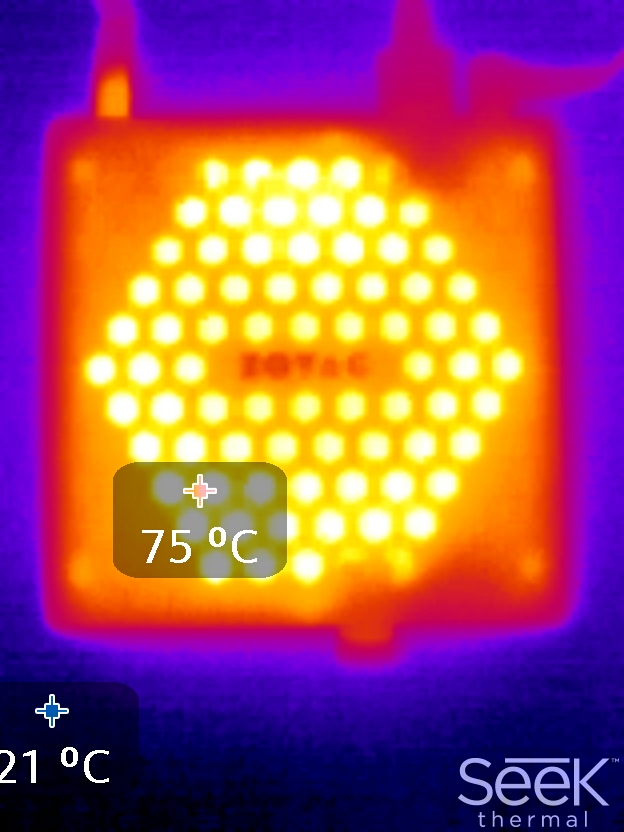Zotac ZBOX CI540 nano Review: A Fanless Haswell-Y mini-PC
by Ganesh T S on October 31, 2014 11:00 AM ESTPower Consumption & Thermal Performance
The power consumption at the wall was measured with a 1080p display being driven through the HDMI port. In the graphs below, we compare the idle and load power of the Zotac ZBOX CI540 nano with other low power PCs evaluated before. For load power consumption, we ran Furmark 1.12.0 and Prime95 v27.9 together. The numbers are not beyond the realm of reason for the combination of hardware components in the machine.


As expected, the load power consumption tracks the inherent capabilities of the CPU in the system. The Haswell Y-series CPU is more powerful compared to any of the Bay Trail parts that we have seen in mini-PCs before. But, it doesn't beat the ULV ones in the NUC-type machines. We did expect better idle power consumption numbers because of the fanless nature, but Zotac can probably optimize the BIOS a bit to drive this number further down.
While we didn't tear down the system to expose the actual thermal design, FanlessTech does have some pictures of the internals. We evaluated the thermal performance from a system perspective. We start with the system at idle, followed by 30 minutes of pure CPU loading. This is followed by another 30 minutes of both CPU and GPU being loaded simultaneously. After this, the CPU load was removed, allowing the GPU to be loaded alone for another 30 minutes. The various clocks in the system as well as the temperatures within the unit are presented below.
Under pure CPU loading, the core clocks maintain their 1.5 GHz+ speed. However, the addition of the GPU load brings down these clocks further while the system tries to keep itself within the SDP limits. Note that thermal throttling isn't at play here (as the graph below shows). After removal of the CPU load, there is some leeway for the GPU to raise its clocks. However, the CPU clock remains at the specified value instead of winding down (that happens in the idle case, where the CPU can go as low as 600 MHz).
An important point to note is that the DTS never falls to 0. This implies that there is no thermal throttling at play. That said, the Y-series CPU seems to have some internal controls where the clocks are automatically adjusted depending on the workload (to remain within the SDP limitations) even though the core temperatures is not close to the junction temperature.
Another important aspect to keep note of while evaluating fanless PCs is the chassis temperature. Using Seek Thermal's thermal imager, we observed the chassis temperature after the CPU package temperature / DTS reached the steady state value in the above graph.
The gallery below presents some of other thermal images of the unit captured under the above conditions.
75 C for the chassis temperature is pretty hot, but keep in mind that this was after subjecting the unit to power viruses - Prime95 and FurMark are hardly the expected use-cases for these types of systems.


















48 Comments
View All Comments
CrazyElf - Friday, October 31, 2014 - link
To be honest, I'm not too crazy about this "super small" mentality. It seems like people are going super small as an end into itself more than anything else.The problem is that smaller means that more heat has to be put through a small space, as this example here shows. A slightly larger design here I think would have been an advantage.
jabber - Friday, October 31, 2014 - link
Yes it seems you can go from a m-atx box to something minute. Doesn't have to be 'as small as you can make it'. Something the size of say a PS2 or a little smaller would be fine.Calista - Saturday, November 1, 2014 - link
Fully agree, even something in the 20x20x20 cm size doesn't occupy much more size then say a NUC once we include space for cables for power, monitor, keyboard and mouse.Alexvrb - Sunday, November 2, 2014 - link
Agreed. I can't imagine going smaller than a baby ITX box, if for no other reason than it's easier to upgrade or modify. :Djosue16 - Friday, October 31, 2014 - link
Will you guys add LAN latency tests? That is if it can be reliably measured. Also, gigabit Ethernet tests would be nice too.knightspawn1138 - Friday, October 31, 2014 - link
I like the thermal pictures. It looks like a space age furnace or reactor. Or like it's a box of lava. Not sure if I want to hang this on the VESA mount on the back of a $1500 TV set.bobbozzo - Friday, October 31, 2014 - link
Can SSDs tolerate 75C?Shadowmaster625 - Friday, October 31, 2014 - link
$500 for a notebook with no screen and no battery/UPS. What a great deal! Sign me up for 3. NOTzodiacfml - Saturday, November 1, 2014 - link
i agree. the notebook i'm using now is only 250 USD with probably the same performance of this low voltage cpu.kmmatney - Friday, October 31, 2014 - link
I've never had an "HTPC" (I have a windows home server and a WD live player) so I'm not an expert on this, but couldn't a laptop perform the same function? It's cheaper and a lot more capable. $350 gets you a core i5 laptop with HD4400 graphics not to mention a keyboard, screen, and OS. Maybe it takes a little more space, but having the screen would make it easier to setup.